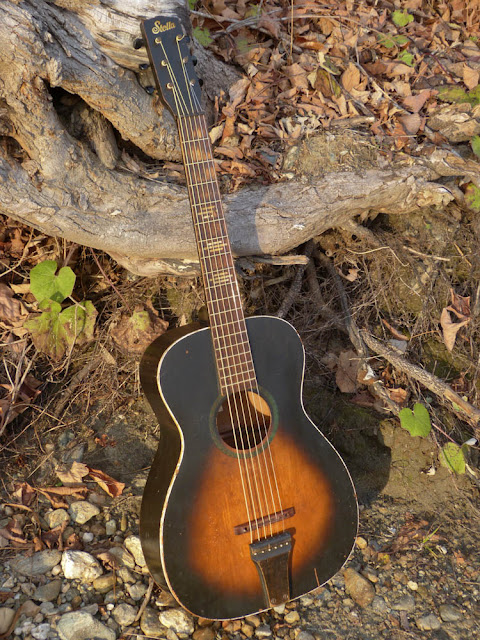1940s Harmony H918 Stella Tailpiece Parlor Guitar
This poor old wartime Harmony (the Stella named transferred from Oscar Schmidt to Harmony in '39) has been bouncing around the workshop for a year-plus. A "friend of a friend" brought it in and it was marked as low priority. It's finally done after tons of crack repairs, seam repairs, a low-brow neck stabilization, fret level/dress, new bridge, parts-scrounging, and setup. I know -- it was a lot to put into what's essentially an all-birch student guitar. But, ya know, folks love these things. They definitely have their own voice. Did I mention I had to reglue just about every brace, too? Hoy...
It appears to be an H918 model -- the forerunner of the venerable H929.
It appears to be an H918 model -- the forerunner of the venerable H929.
When I reglued all the top braces (grr) I changed the bracing pattern. Harmony didn't change the pattern on these boxes depending on if they were setup for pin or tailpiece load. A tailpiece guitar can use less bracing because of how the tension is dealt with differently, and since all the bracing was loose anyway I decided to step down to two lower bout braces (plus top-wide "bridge plate" strapping brace) rather than three. This opened up the tone and volume a bit more and is plenty stable. I actually borrowed the same pattern as on old 1920s "actual" tailpiece Stellas.
All the hardware is original save for one tuner shaft and the bridge.
I've always liked the "deco" sprayed-on markers on these old Stellas. The brass frets are now all in good order but the bigger v-shaped neck and 1 3/4" nut (flat profile board) is a bit of a handful.
Can't argue with a green/gold "rosette" stencil.
The wood tailpiece is a symptom of wartime shortages for metal. The bridge is actually an old archtop guitar topper that I repurposed for this. I wanted something that "looked period" -- well, it is period.
I also modified the stringing method on the tailpiece to shoot the strings out the bottom of it instead -- which means that this gets better back-angle on the saddle and keeps the tail from rattling on the top (the normal stringing method pulls it down as a mute on the top as well -- sigh).
Oh, what a lot of hairline cracks on the back! They're all cleated-up, too. Let's also try not to think about how 2/3 of all the seams were coming undone...
These are the same old Kluson strip tuners used on good-quality Gibsons, too.














Comments